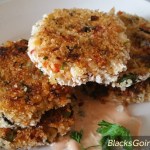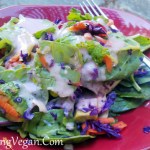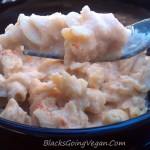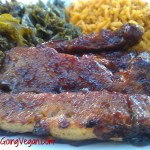Vegan Diet for Diabetes – Meal and Snack Ideas
Changing Your Diet to Manage Diabetes
Dietary modifications are the foundation for treating pre-diabetes and full-on Type 2 diabetes. If you’ve been trying the standard diabetic diet without much alleviation in your symptoms, you might want to run the vegan diabetic diet by your doctor or Registered Dietitian. The most popular dietary treatment for diabetes recommends that patients restrict portion sizes, measure and weigh all their food, and diligently monitor the grams of carbohydrates eaten at every meal, with strict limits on carb intake.
However, evidence from scientific studies suggests that a different dietary approach may be more effective and easier to follow. Part of the value of a low-fat, plant-based diet is that it is very low in saturated fat—that is, the kind of fat that is found especially in meats, dairy products, and tropical oils (coconut, palm, or palm kernel oil).

For more information on how to change your diet to a vegan, plant-centered diabetes eating plan, check out Dr. Neal Barnard’s book.
MEAL SUGGESTIONS
BREAKFAST— Often breakfast can be similar to the one you are accustomed to with a few simple modifications.
• Hot cereals: oatmeal with cinnamon, raisins, and/or applesauce
• All-Bran or muesli with nonfat soy or rice milk and/or berries, peach, or banana
• Apples, strawberries, bananas, oranges or other fruit
• Pumpernickel or rye toast, topped with jam (no butter or margarine)
• Oven-roasted sweet potato “home fries” solo or smothered with “sautéed” mushrooms, peppers, and onions
If you like extra protein with breakfast:
• Fat-free meat substitutes (e.g., Gimme Lean fat-free “sausage” or “bacon”)
• Burrito filled with “refried” beans, lettuce, and tomato (no egg or cheese)
• Tofu scrambler
LUNCH— Whether you dine in or out at lunch, there are lots of healthy and delicious options from which to choose. Here are some ideas to get you started:
Salads
• Garden salad with lemon juice, fat-free dressing, or soy or teriyaki sauce
• Legume-based salads: Three-bean, chickpea, lentil, or black bean and corn salads
• Grain-based salads: Noodle, couscous, bulgur, or rice salads
• Commercial bagged salad brands are fine, but look for the fat-free or no-added-fat versions
Soups
• Vegetable-based soups: carrot-ginger, mixed vegetable, mushroom-barley, etc.
• Legume-based soups: black bean, vegetarian chili, spinach lentil, minestrone, split pea, etc.
• Instant or prepared soups as long as they are low-fat and free of animal products.
Sandwiches/Wraps
• Black bean dip, peppers, tomatoes, and lettuce wrapped in a whole wheat tortilla
• CLT: cucumber, lettuce, and tomato sandwich with Dijon mustard on pumpernickel or rye bread
• Hummus sandwich tucked into whole wheat pita with grated carrots, sprouts, and cucumbers
• Black bean and sweet potato burrito with corn and tomatoes
• Sandwich made with fat-free meat alternatives such as barbeque seitan, Lightlife Smart Deli turkey style, or Yves veggie pepperoni slices and your favorite sandwich veggies
DINNER — Emphasize vegetables and legumes and grains in all your meals. For many, the evening meal is a good place to try new items. Typically you might start with a bean, rice, or other grain or potato dish and add a couple of vegetables.
Legumes: Use generous amounts of legumes. Pintos, vegetarian refried and baked beans, black beans, garbanzos, kidney beans
Starches:
Potatoes: Favor sweet potatoes and yams, instead of white potatoes.
Grains: pasta, brown rice, boxed rice dishes, couscous
Breads: Pumpernickel, rye, or whole-grain breads are preferred. Avoid sweet breads that contain oil, eggs, or milk.
Vegetables: Try any vegetables you like.
• Steamed
• Roasted with herbs
• Fresh
Main Dishes:
• Pasta marinara: Some commercial sauces are fine (any brand that has less than 2 grams fat per serving and is free of animal products).
• Beans and rice: Try black beans with salsa, vegetarian baked beans, or fat-free refried beans.
• Soft tacos: Prepare this dish with a flour tortilla, beans, lettuce, tomato, and salsa.
• Fajitas: Lightly sauté sliced bell peppers, onion, and eggplant in a nonstick pan, with fajita seasonings.
• Chili: Vegetarian boxed or canned versions are fine.
• Veggie lasagna: Made with low-fat tofu to replace the ricotta, layered with grilled veggies.
• Vegetable stir-fry: Season with soy sauce or other low-fat stir-fry sauce. Be sure to use a nonstick pan. Serve over pasta, beans, or rice.
• Fat-free vegetarian burgers: Look for lentil burgers or other commercial brands.
Desserts:
• Fresh or cooked fruit
• Fruit smoothie
Snacks:
• Fruit
• Carrot, celery, or other vegetables with low-fat hummus
• Vegetarian Cup o’ Soup brands (split pea, lentil, etc.)
• Baked tortilla chips with salsa or bean dip
• Air-popped popcorn
• Toast with jam (no butter or margarine)
Category: Veganism and African Americans

























